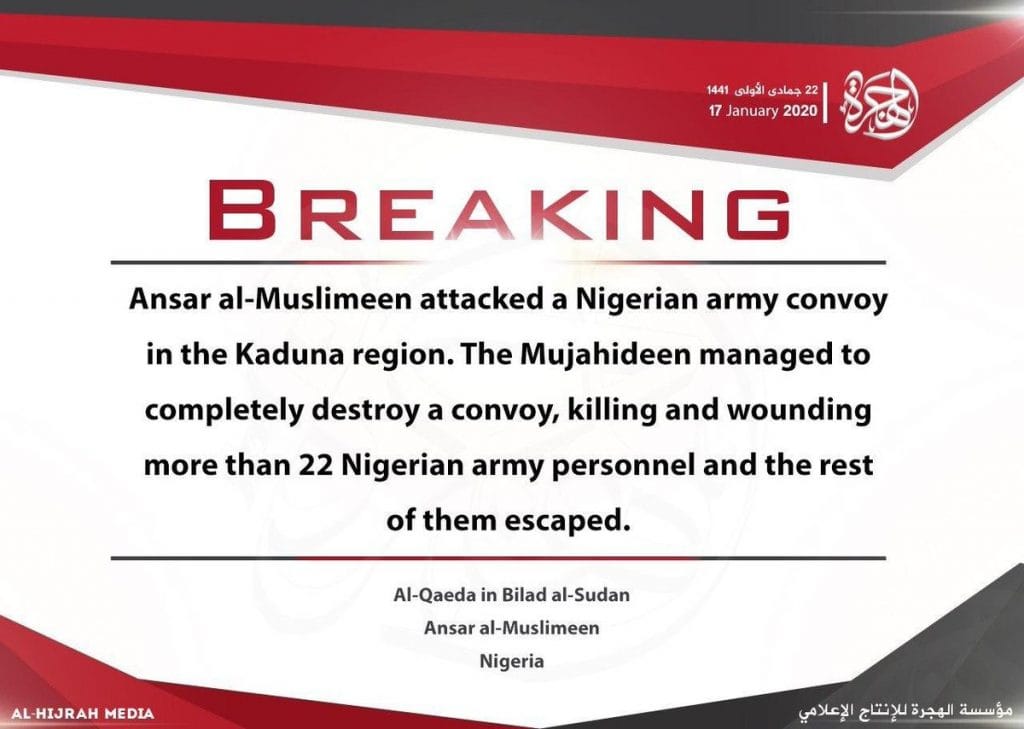
In its first claimed operation since at least 2013, the al Qaeda-linked Jamaat al Ansar al Muslimeen fi Bilad al Sudan, better known as Ansaru, has officially returned to Nigeria’s jihadist scene.
On Wednesday, at least six Nigerian soldiers were killed after being ambushed along the Kaduna-Zaira highway in the country’s north. The soldiers were part of the convoy of the Emir of Potiskum of Nigeria’s Yobe State, who was believed to be the main target.
While Nigerian officials initially reported that six soldiers were killed by “gunmen in military uniforms,” other officials have been quoted by local media as saying that the “feared death toll was at least 30 [soldiers].” Additionally, several soldiers have been reported missing or kidnapped.
For its part, Ansaru claimed to have killed 22 Nigerian troops, including destroying several vehicles. However, no mention was made of any kidnapped soldiers or civilians. The jihadist group also did not mention the Emir of Potiskum as being the target.
The claim was made via al Qaeda’s Al Hijrah Media, which routinely publishes claims and translations from various groups within al Qaeda’s vast global network.
Prior to the statement from Al Hijrah, several Ansaru and al Qaeda-linked social media channels also claimed the ambush was perpetrated by Ansaru’s men.
Today’s attack claim comes after Ansaru announced its return in October by releasing a new photo of its men inside Nigeria.
While the photo itself offered little information, the release was meant to demonstrate Ansaru’s continued existence and presence inside Nigeria. This attempted resurgence has been hinted at in al Qaeda’s propaganda in the past.
For instance, in 2017, Al Risalah Magazine, a former publication released by al Qaeda-linked jihadists in Syria, published an article penned by Usama al Ansari. Ansari, who was described as Ansaru’s emir, heavily criticized Abubakar Shekau, offered a detailed history of the group, and spoke highly of al Qaeda’s men around the world in the piece.
That article was the first sign of life for the group in almost two years at the time.
Prior to the magazine article, the last Ansaru publications were in early 2015. In January and February of that year, two videos were released by the jihadist group with the aim of distancing itself from the actions of Abubakar Shekau and his Boko Haram.
In the videos and aforementioned magazine article, Ansaru’s leaders closely stuck to al Qaeda’s guidelines for jihad. This was not surprising as the history of the group is closely tied to al Qaeda in the Islamic Maghreb (AQIM).
Two of Ansaru’s founders and leaders were trained by AQIM’s men in Mali. In some instances, Ansaru’s men even took part in al Qaeda’s operations in the Sahel and further claimed attacks inside Nigeria in defense of AQIM in Mali.
And in 2013, Khalid al Barnawi, the former leader of Ansaru, referred to Ayman al Zawahiri as “our good emir” and praised al Qaeda’s branches around the world.
After Boko Haram pledged allegiance to the Islamic State in March 2015, Ansaru has widely been regarded as al Qaeda’s franchise in Nigeria.
However, following fierce competition with Boko Haram, and later the Islamic State West Africa, and the arrest of Barnawi in 2016, Ansaru was severely weakened and largely relegated to a state of dormancy.
Today’s claim is meant to demonstrate that Ansaru has finally become operational after a long hiatus of dormancy and that it can be an alternative jihadist entity to join.
Though given the presence of both the Islamic State’s West African Province and Jamaat Ahl al Sunnah, led by ‘Boko Haram’s’ Abubakar Shekau, it remains to be seen how successful Ansaru’s resurgence will be.







